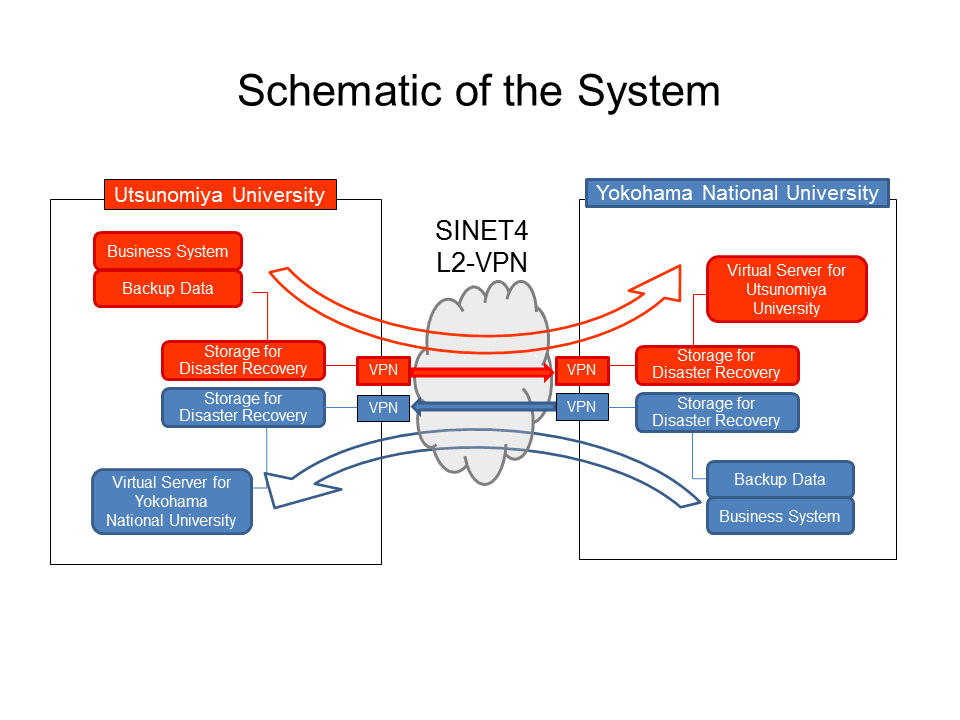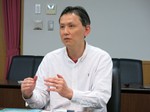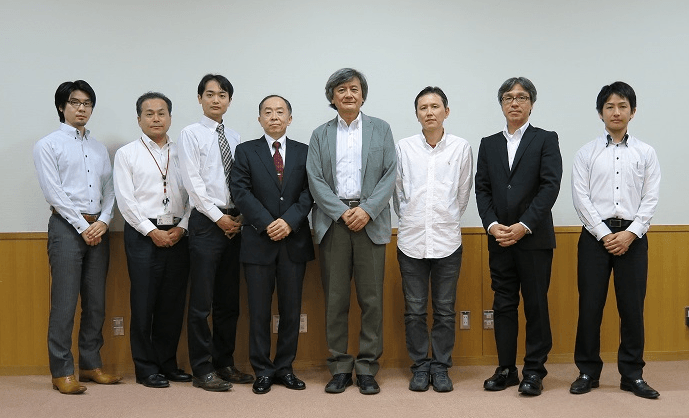
An IT-BCP Mission-Critical System for Quick Restoration of University Operations
Two national university corporations, Utsunomiya University and Yokohama National University, are working together to construct an IT-BCP mission-critical system with the use of L2-VPN from SINET. We spoke with Akira Nagai, a professor, assistant president and manager of the Media Network Center, Utsunomiya University, Yoshiki Mihara, an assistant professor at Utsunomiya University, Yuichi Hasebe, manager of the Information Technology Service Center and a professor of the Graduate School of International Social Studies at Yokohama National University, and Toshiya Shimura, an assistant professor at Yokohama National University, about the outline and purposes of the system.
The IT-BCP mission-critical system is no mere data backup system, it is a standby system that operates when either university’s system is down following a disaster or equivalent event for the purpose of quickly restoring university operations.
(Interview date: October 15, 2013)
Utsunomiya University and Yokohama National University have recently signed an agreement on collaboration in university information strategies.
Can you tell us about its background and past developments?
Nagai:Utsunomiya University has long seen university information assets as resources that are significant not only to education and research but also to university management. We have pursued a number of different initiatives and were certified with the ISO 27001 standard for information security management systems in 2007. Among these actions, the program for mutual data backup cooperation with Yokohama National University was launched in 2009. After the experience of the Great East Japan Earthquake, educational institutions are working to strengthen their business continuity planning (BCP). We also realized the importance of security and reassurance. The agreement was thus signed between the two universities in an attempt to further improve the system and to push ahead with the program.
Hasebe:In 2008, Yokohama National University drew up a grand design for computerization for the future. It was intended to work out a solid master plan on computerization of the whole university and to systematically carry out the procurement of equipment and construction of a uniform authentication platform and other systems. The priority challenges in this initiative included BCP-related matters such as data backup. Should any loss of information about students or teaching staff or of business data occur, it would severely affect university management. Fortunately, there was a foundation that facilitated collaboration between our university and Utsunomiya University. The presidents of the two institutions had good personal relations. That led to the agreement. At the moment, our university is endeavoring to acquire ISO 27001 certification. We expect to obtain it within fiscal 2013.
Under the agreement, the two universities will cooperate in university information strategies, the protection of university information assets and business continuity planning and university information security management, among other areas.
What actions have you been taking for BCP?
Nagai:It is of course important to improve hardware and software, but we held discussions from a broad viewpoint covering institutional and operational aspects. We shared an orientation towards mutual cooperative operations but excessively rigid operation rules could hinder smooth advancement. We therefore sought a flexible style of implementation including institutional design. Given that the existence of data alone will not guarantee a quick recovery of operations, we aimed to create an environment that was complementary in operation service functions. We are grateful that this BCP cooperation allows us to anticipate a strengthening of trust between the staff concerned, personnel development, and the growth of all parties.
Hasebe:Another characteristic of this program is that it is not only a project for building an IT-BCP mission-critical system, but an opportunity in which staff at both centers can learn and achieve personal development. Both centers have their own advanced initiatives. The personal exchanges of their knowledge and expertise will be a major asset. In fact, both centers dispatch human resources to each other. One person commented that the dispatch has given him a good opportunity to review his own own organization and working style. Another says that he has built relations for mutual consultation on any topic with people in different organizations through this activity.
You use SINET’s L2VPN service for the network.
Shimura:A big challenge in this project was to transfer important data assets of the universities at high speed without exposing them to any threat. The Internet was out of the question and, in using a VPN, we wanted to avoid making the VPN router accessible to public. We turned our attention to SINET’s L2VPN service. With this service, the VPN environment needed for data transfer is created on the part of SINET and there is no need to prepare any equipment. In addition, it provides sufficient bandwidth to ensure that data transfer has no adverse impact on other operations. It is no exaggeration to say that SINET’s L2VPN service has made this project possible.
Specifically, how does the backup process take place?
Mihara:At each university, a backup storage device with remote replication functions is installed. These devices capitalize on this function to transfer data during the day and at night. Many important systems associated with university management are subject to the backup. The storage overlap elimination feature and the compression feature work so effectively that the replication time is not as long. A uniqueness in terms of the network is that each of the universities has one L2VPN line to separately carry out operation and management. The purpose of this configuration is to make clear the point of demarcation of responsibility for ensuring information security and for preventing failure arising from human error.
How do you evaluate the project and what do you expect from SINET?
Nagai:I feel that it was a valuable experience for two universities to work together to smoothly create the system for protecting important information assets. However, our activities have not finished and it is important to continue to make improvements. This project is a joint project between the two universities. If the system covers more universities, the current configuration may not be optimal. It may be desirable to use a better location on the network in the future. Our university sincerely appreciates the NII’s valuable technical and institutional assistance. We would be grateful and we wish for its future support for us in BCP as well.
Hasebe:I specialize in economics. I think that the construction of this high-speed and secure IT-BCP mission-critical system will serve as an advanced example in studying the management of universities and research institutions. While BCP was the main purpose of the project, universities have numerous significant information assets concerning education and research. At the moment, they are managed by individual researchers. In the future, how these data should be preserved will emerge as an important issue. It is in a sense difficult for universities to independently back up their huge research data. We therefore have high hopes for the services from the NII and SINET.






